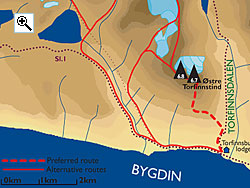Scandinavian Mountains over 2000 metres - James Baxter
Areas › Slettmark Mesmog Massif › 6.7 Østre Torfinnstind (2119m)
Østre Torfinnstind, 2119m, lies in the wild and serrated tract of mountains between the lakes of Gjende and Bygdin, probably the most alpine mountains over 2000 metres outside the Hurrungane region. Østre Torfinnstind is the easternmost and highest point on a craggy massif comprising two mountains over 2000 metres and a further peak over 2000 metres. The looming shape of Torfinnstind will be familiar to anyone who has taken the Bitihorn boat along Lake Bygdin. Although Østre Torfinnstind is a challenging scramble requiring some mountaineering experience, it is not a climb in good dry conditions.
| The Route from Torfinnsbu Lodge | |
|---|---|
      |
|
 Leave Torfinnsbu lodge and follow the path Sl.2 north into the Torfinnsdalen valley toward Gjendebu lodge for 1 km when the gradient levels off by a large cairn. At this point there is a small ravine leading north west up towards Østre Torfinnstind for about 1 km. Follow this ravine up until it merges into the slope. Continue up this slope for about another 750 metres until you reach the bottom of the crags.
Leave Torfinnsbu lodge and follow the path Sl.2 north into the Torfinnsdalen valley toward Gjendebu lodge for 1 km when the gradient levels off by a large cairn. At this point there is a small ravine leading north west up towards Østre Torfinnstind for about 1 km. Follow this ravine up until it merges into the slope. Continue up this slope for about another 750 metres until you reach the bottom of the crags.
Do not start to go up yet but follow a line along the bottom of the crags in a westerly direction for about 800 metres, much of it across boulders. Eventually you will come to a rocky ravine which is about 10m deep. This is the bottom of a long gully that comes down from nearly the top of Østre Torfinnstind. The gully is not so obvious from here but become more so after starting to ascend.
The South Face Gully
 Start to ascend on the east side of the gully, where it is not so steep, for about 100m (and 50 vertical metres) and then cut back west again to a shallower area filled with boulders.
Start to ascend on the east side of the gully, where it is not so steep, for about 100m (and 50 vertical metres) and then cut back west again to a shallower area filled with boulders.
On the north-west side of the sloping boulder-filled shelf is an obvious gully, full of large boulders. This gully is steep and quite narrow to start with.
The gully goes up for 700m in a continuous gradient of about 40 degrees involving about 300m of vertical ascent after which it narrows again.
Before this narrowing it is best to cross over a small arête to the east (right) to an adjacent gully which is slightly easier to ascend. After another 200metres, with 100metres of vertical ascent, the separating arête disappears and the two gullies merge again.
 Continue up for another 200metres again with a 100metres of vertical ascent passing a more demanding section of scrambling, possibily as much as grade III in places, until the merged gully ends in a natural amphitheatre with a steep gully to the east (right) of it, which leads up onto the apex of the main East Ridge.
Continue up for another 200metres again with a 100metres of vertical ascent passing a more demanding section of scrambling, possibily as much as grade III in places, until the merged gully ends in a natural amphitheatre with a steep gully to the east (right) of it, which leads up onto the apex of the main East Ridge.
Ignore this gully to the east and try and identify a confused rising ledge which leads out across the amphitheatre for about 50 m towards the west where it meets the spur descending down from the main ridge.
Top Spur
Follow this ledge out to the west of the amphitheatre and gain the spur. The route now largely follows the spur up for 60 metres of very enjoyable scrambling. Initially follow the spur for about 15 metres before it arrives at a steep section which is avoided by following a ledge to the east (right) for another 15 metres. At the end of this ledge the route cuts back onto the spur again with another 15 metres of scrambling. Once the spur is gained there is another 15 metres up the apex of the spur to reach a flatter area on the main ridge itself.
 Once on this flatter area on the main ridge it is a very simple amble for 200 metre along the main ridge which curves to the west and ends in the coveted summit of Østre Torfinnstind.
Once on this flatter area on the main ridge it is a very simple amble for 200 metre along the main ridge which curves to the west and ends in the coveted summit of Østre Torfinnstind.
If this is the only mountain to be climbed the return is by the same route as the ascent. If the traverse to Midtre and Vestre Torfinnstind is being made then descend the west ridge as described on the alternative routes page and continue west as described on the Midtre Torfinnstind page.

